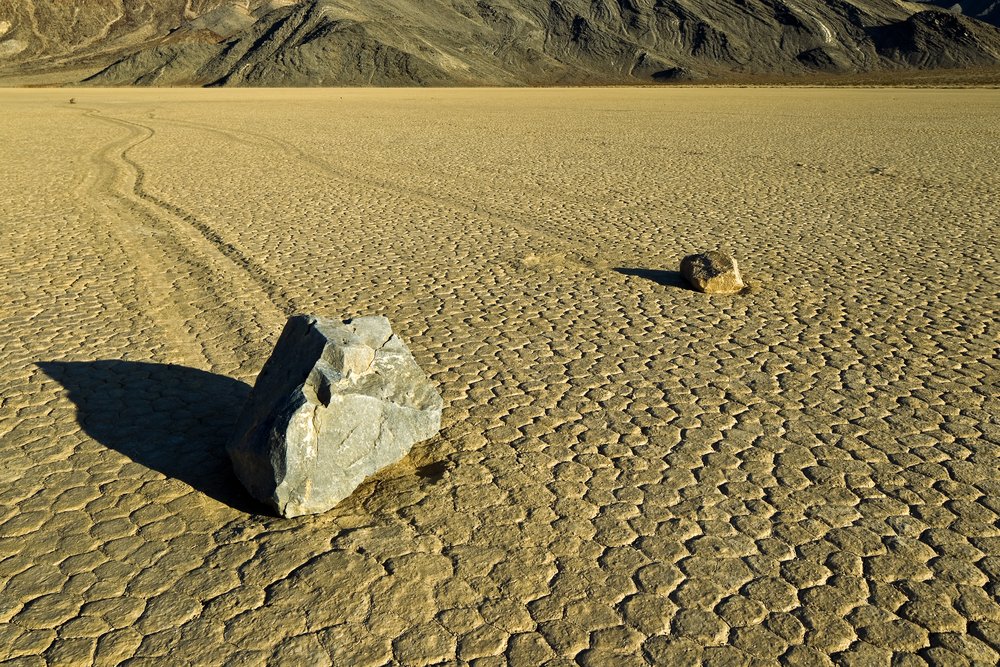Mystery of Death Valley's 'Sailing Stones' Solved

For years, scientists have been puzzled by the mysterious "sailing stones" of Death Valley.
Located in a remote area of California's Death Valley National Park, the heavy stones appear to move across the dried lake bed known as Racetrack Playa, leaving a trail behind them in the cracked mud.
The rocks' apparent movement has been blamed on everything from space aliens and magnetic fields to pranksters. But no one has actually seen the rocks move, which only adds to the mystery. [Images: One-of-a-Kind Places on Earth]
"It's very quiet out there, and it's very open — and you tend to have the playa to yourself," park ranger Alan van Valkenburg told Smithsonian.com. "And the longer you stay out there, it just takes on this incredible sense of mystery."
Scientists have tried to solve the puzzle of the sailing stones for decades. Some researchers thought that dust devils might move the rocks, some of which weigh as much as 700 lbs. (318 kilograms).
Other researchers believed the strong winds that frequently whip across the vast lake bed could cause the rocks to slide across the ground. These and other theories were eventually disproved, leaving scientists without an explanation.
In some cases the rocks' trails were measured to be as long as 820 feet (250 meters), according to Slate.com. Some of the trails formed a graceful curve, while other trails created a straight line, then an abrupt shift to the left or right, which further baffled researchers.
Sign up for the Live Science daily newsletter now
Get the world’s most fascinating discoveries delivered straight to your inbox.
From outer space to Death Valley
In 2006, Ralph Lorenz, a NASA scientist investigating weather conditions on other planets, took an interest in Death Valley. Lorenz was particularly keen on comparing the meteorological conditions of Death Valley to those near Ontario Lacus, a vast hydrocarbon lake on Titan, a moon of Saturn.
But while investigating Death Valley, he became intrigued by the enigmatic sailing stones of Racetrack Playa.
Lorenz developed a kitchen-table model — using an ordinary Tupperware container — to show how the rocks might glide across the surface of the lake bed.
"I took a small rock and put it in a piece of Tupperware, and filled it with water so there was an inch of water with a bit of the rock sticking out," Lorenz told Smithsonian.com.
After putting the container in the freezer, Lorenz ended up with a small slab of ice with a rock embedded in it. By placing the ice-bound rock in a large tray of water with sand at the bottom, all he had to do was gently blow on the rock to get it to move across the water.
And as the ice-embedded rock moved, it scraped a trail in the sand at the tray's bottom. Lorenz devised his clever experiment by researching how the buoyancy of ice can cause large rocks, when encased in ice, to move by floating along tidal beaches in the Arctic Sea.
Preferring mysteries to science
Lorenz's research team calculated that under certain winter conditions in Death Valley, enough water and ice could form to float the rocks across the muddy bottom of Racetrack Playa in a light breeze, leaving a trail in the mud as the rocks moved.
Nonetheless, some visitors to Death Valley seem to prefer more occult explanations for the sailing stones.
"People always ask, 'What do you think causes them to move?' But if you try to explain, they don't always want to hear the answers," van Valkenburg said. "People like a mystery — they like an unanswered question." Follow Marc Lallanilla on Twitter and Google+. Follow us @livescience, Facebook & Google+. Original article on LiveScience.com.











